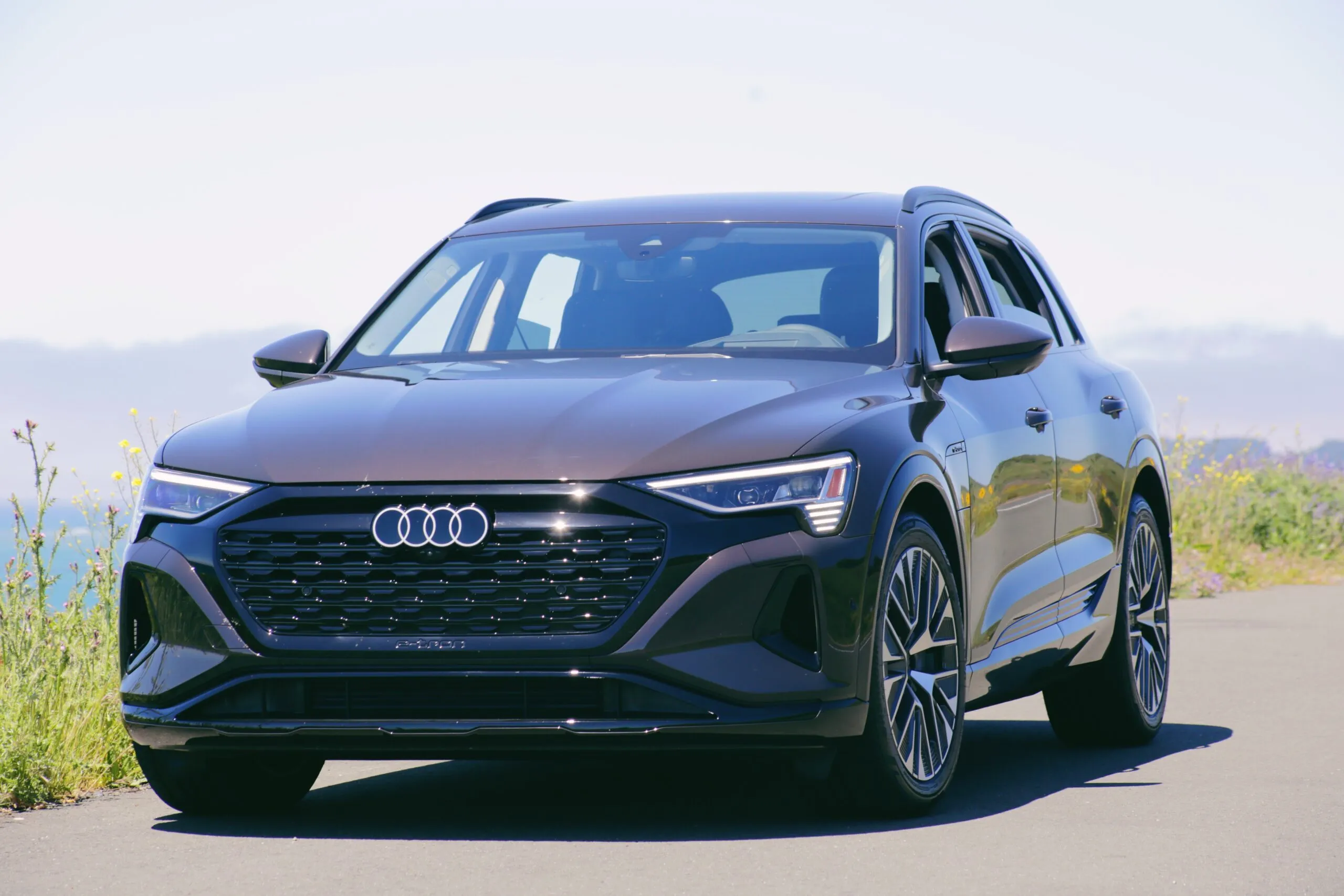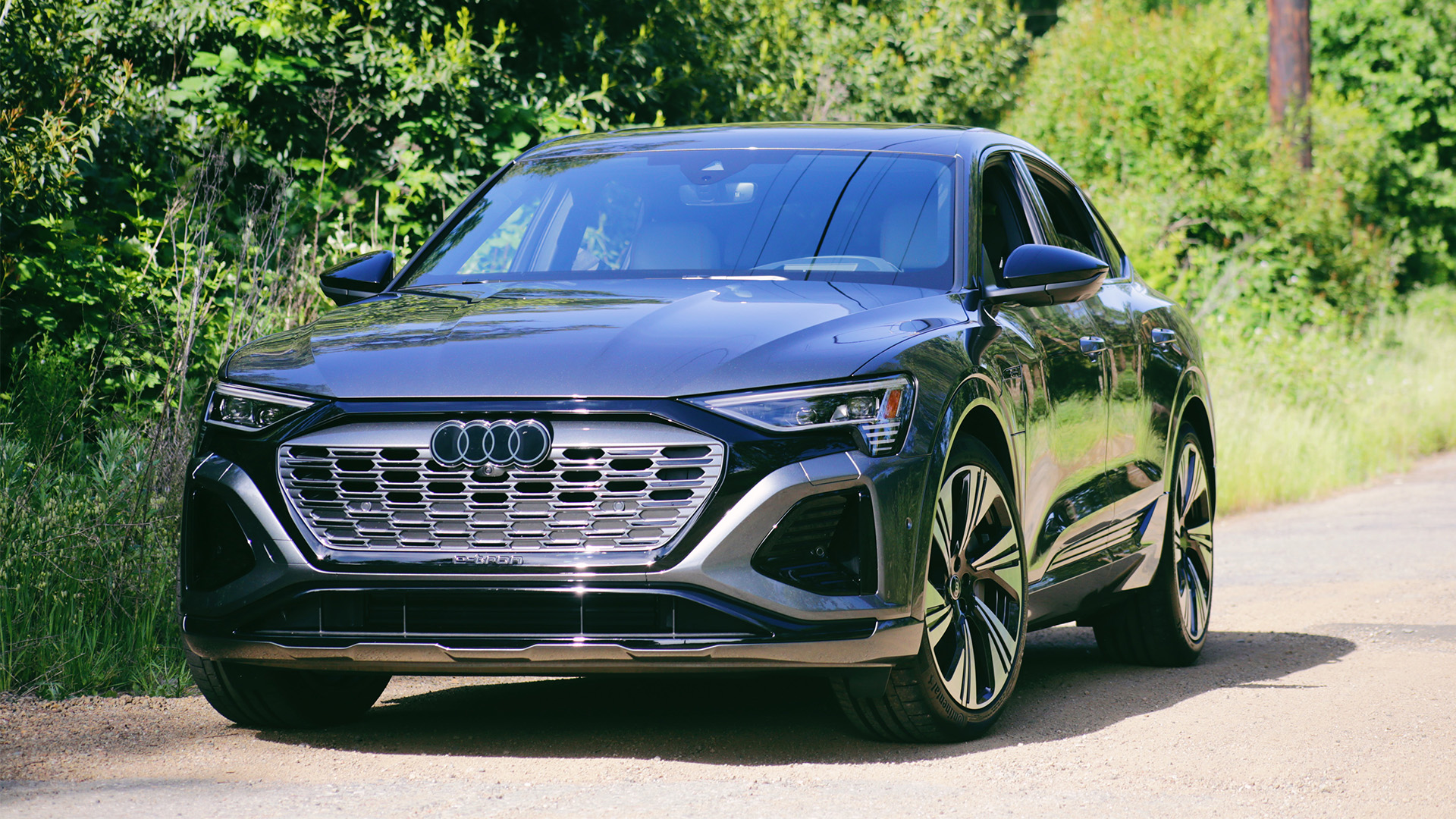The mid-size electric crossover segment is rapidly getting crowded. This is forcing automakers to explore different designs, go heavy with features, and utilize performance DNA to sweeten their offerings. And with the popularity of crossovers only growing, it’s an easy segment for automakers to showcase what they can really do. Such is the case of the 2024 Audi Q8 e-tron and its Q8 Sportback sibling.
The expansion of the e-tron subbrand takes on the Q8 badge for 2024. It still comes in both traditional SUV and Sportback body styles and represents a host of changes and upgrades that give it more range, more comfort, a better ride, and better cornering skills.
I got behind the wheel of both variants in Sportback S Line e-tron Launch Edition trims to see what they were all about. Here’s how my day full of both twisty roads and highway stints went with Audi’s newest EVs.

2024 Audi Q8 e-tron Specs
- Base price ( as tested): $75,595 (Prestige: $88,990, Sportback S line e-tron Launch Edition: $95,990)
- Powertrain: front and rear asynchronous electric motors | all-wheel drive
- Horsepower: 402 hp
- Torque: 490 lb-ft
- Seating capacity: 5
- Curb weight: 5,798 pounds
- Towing capacity: 4,000 pounds
- Cargo volume (with rear seats folded): SUV: 28.5 cubic feet (56.4), Sportback: 27.2 cubic feet (54.5)
- Ground clearance: 8.1 inches
- 0-60 mph: 5.4 seconds
- Top speed: 124 mph
- EPA fuel economy: 80 mpge city | 83 highway | 81 combined, Range: 285 miles (300 with Q8 Sportback S Line e-tron quattro with the ultra package)
- Quick take: An serene driving experience that packs some solid thrills when you want them.
- Score: 8/10

The Basics
On the outside, the new Q8 e-tron doesn’t look terribly different from its predecessor. It’s still a mid-size luxury crossover that comes in both SUV and Sportback body variants, just with enough subtle changes throughout to help solidify the Q8 as the brand’s freshest, top e-tron offering. After all, Audi calls the electrified 2024 Q8 its plug-powered flagship.
The new front grille and lower rear bumper areas, including some front-facing venting that doubled as aerodynamic improvements certainly stand out. These were updated just enough to give it a refreshed look, and I particularly liked the blacked-out badging and body trim on the Sportback S Line Launch Edition. Its 22-inch wheels were wrapped in 265-wide Continental summer tires which gave it an especially muscular look.
Inside, the Q8 e-tron’s interior was an overall pleasant and airy place to be, with leather stretched across its seats, door cards, and every non-haptic-screen touchpoint, including the steering wheel, armrest, and pad that houses the gear selector.



The interior has a high-end feel to it—as it should—and its eight-way-adjustable seats with massaging, heating and venting, were among the most comfortable I’ve experienced. The glass panoramic roof and all-around visibility are excellent, even in the slightly more cavernous Sportback. The driving position was top-notch, too; I didn’t feel like I was seated up above the belt line like in some crossovers, but I didn’t feel deep down either. It was a nice middle ground with an excellent panoramic forward view and all the headroom that my six-foot, three-inch stature could’ve asked for. The backseat in the SUV is equally as spacious, but the Sportback cuts down headroom from 38.6 inches to 37.9 inches, and I definitely felt it.
The only feature inside that bugged me were the upper (10.1-inch) and lower (8.6-inch) haptic touchscreens encased in piano-black trim, as they accumulated gross fingerprints rather quickly. Still, paging through infotainment and making HVAC adjustments were generally easy to figure out, despite some occasional lag between screens and prompts brought on by voice commands.
Lastly, while on the subject of lag: the Q8’s door handles are powered instead using a simple, analog latch mechanism. Prospective buyers might not like the lag that occurs with a quick pull. Then again, most, if not all of the Q8’s competitors feature the same door handles.

The 2024 Q8 e-tron underwent a host of updates to bolster its position in the growing segment. Its 106 kWh net capacity is 23 percent higher than the previous model, and DC fast charging has been bumped up to 170 kW over the prior’s 150 kW, which means reaching 80 percent capacity up from 10 percent in as little as 31 minutes. For level 2 charging, Audi says it’ll take 6.5 hours at 19.2kW on a 240V/80A service to reach full capacity.
The asynchronous motors on each axle offer little to no drag resistance off-power—even when clicked down to the lowest setting via the steering paddles—and the rear was redesigned to produce more torque with less energy. Then, there are some noteworthy aerodynamic improvements. These include wheels that cut down on drag, electric shutters on the grille, and venting on the outer edges of the front bumper that create an air curtain around the car.



Audi says it’s six percent more aerodynamic than the outgoing model, with drag coefficients working out to 0.29 for the Q8 e-tron SUV, and 0.27 for the Sportback model. It really looks like it in person, too. While this large crossover’s face is significant, and it’s dimensionally brutish, it looks slipperier than before.
Add all this up, and Audi says the Q8 e-tron will reach a maximum range of 300 miles on a single charge—specifically the top-end Sportback. However, that figure will diminish with different wheel styles and tires and varies by body style. The base SUV model is EPA-rated at 285 miles, and the Sportback S Line quattro at 296. This is up from around 220 across the board for the old model.

Driving Experience
Over 200 miles of picturesque Northern California roads helped me get acquainted with the Q8 e-tron, including some twisty stints on the Pacific Coast Highway north of San Francisco.
Audi says the Q8 e-tron will do zero to 60 mph in 5.3 seconds. Rather refreshingly, it didn’t have a typical, brutal, flat EV torque curve. Instead, the power output felt more progressive, as if it were an internal combustion powerplant with variable valve timing to give it an extra little push in the midrange.



I first drove the Sportback S Line with its 265-wide Continental summer tires. While cruising along with the Q8’s air suspension set to comfort, it had a genuinely excellent ride quality. Rough imperfections in the road were smoothed over quite well, yet it in no way ever felt too floaty or disconnected.
But my favorite setup was dynamic mode with the gear selector set to S, which tightened up the air suspension, put the car at its lowest ride height, and made it an absolute joy to carve through some particularly tight roads. In S, power output is split more evenly between the front and rear axles, as opposed to D, which is rear-biased.

Audi says it boosted the Q8’s four-wheel, five-link fully independent suspension’s overall rigidity over the old model’s. It’s got a quicker steering ratio (14.6:1 compared to the previous generation’s 15.8:1), too, which made it feel far more nimble than its hefty curb weight would normally entail. Turn-in was direct, and there was even a decent amount of feedback through the steering wheel, which also gained some nice weight off-center in tight corners.
While I kept my foot pressed confidently against the throttle, the Q8 felt planted and sure of itself through tight chicanes. Its weight felt evenly dispersed across all four corners under heavy braking. The chassis was nicely centered while braking, turning in, and powering out of tight corners.
Then it was time for the Q8 e-tron Prestige with 21-inch all-season tires. The fun continued, but turn-in was more delayed and vague, and the tires were understandably not quite as up to the task of holding momentum through fast, long sweepers. Still, the boxier EV had more grip and mid-corner posture than anyone might assume. Switching to D and putting the air suspension back to comfort exasperated the Q8’s calming, quiet interior and lack of wind and road noise. It made for a relaxing driving experience on the highway toward the end of the drive route.



Price and Competition
As far as competition goes, the ones that have been at it the longest in this segment are the Jaguar I-Pace and Tesla Model X. Then there is the BMW iX and Mercedes-Benz EQS SUV. The latter narrowly beat out the Q8 in range, whereas the I-Pace essentially matches it. The Tesla outdrives them all, touching the mid-300s in Long Range spec.
In the Audi you get the same rated power and acceleration figures across the entire Q8 lineup and a lot of the same interior niceties. Though, only 285 miles of range in the most base spec. Selecting bigger wheel choices, changing up interior materials, and taking advantage of a good variety of optional paint colors quickly brings that up to $95,990.
Comparing base models, the Q8 SUV starts at $75,595, whereas the Sportback variant starts at $78,995. The BMW starts a bit higher at $85,095, Jag commands a lower $72,575, and Tesla hits a significantly higher $101,380. The Benz is substantially higher at $105,550.


Verdict
As far as cobbling together a spacious, comfortable, and quiet driving experience, Audi hits the mark with the 2024 Q8 e-tron SUV and Sportback. It’s a great place to be all day long, I just wish its range would break the 300-mile mark—especially given its price.
Channeling its sporty DNA, the big Q felt equally at home squabbing on roads with the proper suspension and drive settings selected and good summer rubber to match. It doesn’t need to do explosive acceleration because, dare I say, it has more character than that. If you’re still left wanting more, Audi is expected to announce the SQ8 e-tron sometime later this year—and this will likely gain speed with a bit more aggression.
No matter how you slice it, the Q8 e-tron is a solid entry in this growing luxury segment. It offers a lot of equipment for less than $100,000, and more importantly, it’s a joy to drive fast or slow. Your choice.
Email the author at peter.nelson@thedrive.com
